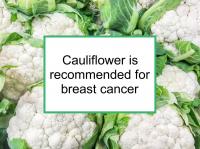Cauliflower (Brassica oleracea var. botrytis) is a cruciferous vegetable. Cauliflower contains fewer micronutrients than other cruciferous vegetables, however it nevertheless is a source of several chemopreventive compounds. Cauliflower components have been shown to reduce the risk of bladder, colorectal, prostate and cervical cancer, among others.
Cauliflower is a source of chemopreventive isothiocyanates, including allyl isothiocyanate (AITC), indole-3-carbinol (I3C) and its metabolic product 3,3'-diindolylmethane (DIM), as well as sulforaphane. In addition, cauliflower incorporates choline, folate and vitamin C.
Breast cancer-related effects of eating cauliflower
Cauliflower consumption is associated with reduced breast cancer risk. Cauliflower and its component molecules have been found to be promote apoptosis, suppress cell cycle progression and inhibit angiogenesis of human breast cancer cells. Furthermore, cauliflower can protect against cell DNA damage. Cauliflower can increase the beneficial effects of some breast cancer treatments. Heavily cooking cauliflower reduces its potential effectiveness in preventing breast cancer or its relapse.
Epidemiological studies
A number of population studies have found a lower risk of breast cancer associated with consumption of one or more cruciferous vegetables. For example, a study based on Italian and Swiss populations reported that consuming cruciferous vegetables at least once per week was associated with a 17% lower risk of breast cancer compared with never or only occasionally consuming cruciferous vegetables.
Cauliflower can increase treatment effectiveness
DIM and I3C have been shown to enhance the therapeutic efficacy of the chemotherapy drugs doxorubicin, paclitaxel and docetaxel in breast cancer cells. For example, the combination of DIM plus paclitaxel has been reported to increase the death of HER2 overexpressing (HER2+) breast cancer cells more than paclitaxel alone in one study.
Cauliflower component sulforaphane has been shown increase the anti-cancer effects of doxorubicin, cisplatin, 5-Fluorouracil (5-FU), paclitaxel and docetaxel. For example, the combination of sulforaphane plus cisplatin has been shown to synergistically inhibit key steps of metastatic cellular growth in triple negative (ER-/PR-/HER2-) breast cancer cells.
AITC has been reported to reduce doxorubicin-induced heart damage (cardiomyopathy) in a rat model of chemotherapy.
Cruciferous vegetables are recommended during aromatase inhibitor treatment in part because several isothiocyanates have been shown to reduce aromatase expression, thereby helping to block the production of estrogens from androgens within the body. Breast cancer patients taking tamoxifen who also had relatively high cruciferous vegetable intake were less likely to experience a recurrence than tamoxifen users with low consumption in one study.
Cauliflower isothiocyanates
Urinary isothiocyanate levels have been found to be related to lower breast cancer risk among both premenopausal and postmenopausal women.
AITC
Cauliflower is a modest source of AITC. Oral administration of AITC has been demonstrated to restore levels of proliferation and aromatase activity to near normal levels in a rat model of breast cancer. Another rat study found that AITC prevented mammary tumor angiogenesis and invasion. A cell study observed that AITC induced ER+/PR+ breast cancer cell death in a dose-dependent manner by causing DNA damage and altering DNA damage repair proteins. A 2025 study reported that AITC reduced the growth and viability of triple positive (ER+/PR+/HER2+) HER2 overexpressing breast cancer cells.
I3C and its metabolic product DIM
Cauliflower is also a source of I3C and DIM. Numerous studies have reported that I3C and DIM reduce the growth, proliferation and migration of various types of breast cancer cells. For example, I3C has been shown to inhibit proliferation of estrogen receptor positive (ER+) breast cancer cells. I3C/DIM has also been shown to inhibit aromatase (the conversion of androgens to estrogens) in both normal and ER+/PR+ breast cancer cells at concentrations in the range of that observed in human plasma.
DIM has been shown to inhibit the growth of transplanted human breast cancer cells in mice. In a separate study, DIM administered to mice injected with cancer cells caused a marked reduction in the number of lung metastases.
Sulforaphane
Sulforaphane is the most abundant isothiocyanate derived from cauliflower. Sulforaphane has been shown to reduce triple negative breast cancer growth and metastasis. A relatively low concentration of sulforaphane has been demonstrated to preferentially eliminate breast cancer stem cells from triple negative cells.
Mice were implanted with breast cancer tumors and the tumors were treated directly with sulforaphane in one experiment. Daily injection with sulforaphane for two weeks was found to reduce the number of stem cells by more than 50% in the xenograft tumors.
Sulforaphane has also been shown to inhibit aromatase in both normal and ER+/PR+ breast cancer cells at concentrations in the range of that observed in human plasma.
Sulforaphane has also been demonstrated to inhibit Herceptin-resistant HER2+ breast cancer.
Additional comments
Cauliflower is most chemopreventive when consumed raw or prepared first by chopping and then by lightly cooking (steaming, stir‐frying, blanching or microwaving), not by heavily cooking (boiling, stewing, or broiling).
Sources of information in this webpage
The information above, which is updated continually as new research becomes available, has been developed based solely on the results of academic studies. Clicking on any of the underlined terms will take you to its tag or webpage, which contain more extensive information.
Below are links to 20 recent studies concerning this food and its components. For a more complete list of studies, please click on cauliflower.
